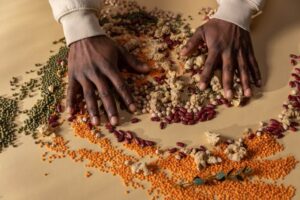Physical Address
23,24,25 & 26, 2nd Floor, Software Technology Park India, Opp: Garware Stadium,MIDC, Chikalthana, Aurangabad, Maharashtra – 431001 India
Physical Address
23,24,25 & 26, 2nd Floor, Software Technology Park India, Opp: Garware Stadium,MIDC, Chikalthana, Aurangabad, Maharashtra – 431001 India

By Aayushi Sharma
India’s dependence on imported pulses has intensified, nearly doubling during the 2023-24 fiscal year to reach USD 3.74 billion. This surge in imports, totaling over 45 lakh tonnes, is primarily driven by the need to fulfill domestic demand and stabilize prices. In response, the government is actively seeking new markets such as Brazil and Argentina to secure long-term supply contracts. Despite implementing various incentives such as duty-free imports and higher Minimum Support Prices (MSP), the country’s domestic pulse production has dwindled in recent years, largely attributed to erratic climate conditions.
Consequently, concerns about inflation have emerged, with the inflation rate for pulses soaring to 17% in March. Recent estimates indicate that shipments have surged past 45 lakh tonnes in the recently concluded financial year 2023-24, marking a significant increase from the 24.5 lakh tonnes recorded just a year prior.
Pulse crop production in India
India holds a prominent position as both the largest producer and consumer of pulses globally. Pulse production in India amounts to roughly 24 million metric tons, encompassing diverse varieties such as chickpeas, lentils, and beans. These pulses serve as crucial sources of protein and nutrients in Indian cuisine. Despite India’s substantial role in global pulse production, the nation encounters numerous hurdles in maintaining and augmenting its production levels.
Hence, for specific varieties like tur, urad, and Masur (lentils), India relies on imports from countries such as Australia, Canada, Russia, Myanmar, Mozambique, Tanzania, Sudan, and Malawi.
Pulse Production Trends in Flux
The gains can be fragile though. Increasing weather uncertainties can quickly firm up prices if output drops. Prices of pigeon pea and black gram have been elevated because of a patchy monsoon last year in rain-fed growing belts in Karnataka, Andhra Pradesh, and Telangana.
Despite government incentives such as guaranteed purchases and higher Minimum Support Prices (MSPs), domestic pulse production has decreased in the last 2 to 3 years. Estimates from the Agriculture Ministry indicate that pulse production in 2023-24 is around 23.4 million tonnes, compared to 26.1 million tonnes the previous year.
India witnessed fluctuations in domestic pulses production over recent years. In 2019-20, production stood at 230.25 lakh tonnes, experiencing a notable increase following government incentives in 2020-21, reaching 254.63 lakh tonnes. This positive trajectory continued into 2021-22, with production further rising to 273.02 lakh tonnes. However, in 2022-23, a decline was observed, with production dropping to 260.58 lakh tonnes.
Looking at the current fiscal year (FY24), projections suggest a decrease in Kharif production from 76.21 lakh tonnes to 71.18 lakh tonnes. Similarly, Urad production is expected to decline from 17.68 lakh tonnes to 15.15 lakh tonnes, while Moong production is projected to decrease from 17.18 lakh tonnes to 14.05 lakh tonnes. Fluctuating weather patterns, including the driest August in over a hundred years, have driven food prices up by more than 11% in India, a significant contributor to global agricultural trade.
Adverse effect of Climate stress on Pulse Production
Climate change affects pulse production in several ways:
Expert Opinion:
Dr. Partick Bond, Distinguished Professor and Director of the Centre for Social Change, University of Johannesburg told CFC India that increasing import of pulses and decline in production is a vital economic impact of climate change. “The high-polluting countries in the West and BRICS+ (Brazil-Russia-India-China-South Africa and now Saudi Arabia, UAE, Iran, Egypt and Ethiopia) owe a vast climate debt. That takes three types: 1) the ‘loss and damage’ they caused by emitting too many greenhouse gases; 2) the adaptation costs to ensure climate-proofing of infrastructure, housing, agriculture, etc; and 3) the compensation to poor countries which won’t be able to use fossil fuels for their own capital accumulation since the West/BRICS+ used too much.”, he said.
“The most rigorous research, factoring in ‘feedback loops’ and taking the value of human life seriously, was done in 2021 by University College London scholars, and their ‘Social Cost of Carbon’ estimate of $3000/tonne should be respected, if we take seriously the ‘precautionary principle.’ That costing was disputed in South Africa’s courts in 2022 but there is no question that global economic damage is going to be far worse than, say, the IMF’s current $63/tonne estimate. We hope leading officials – including deputy IMF managing director and former chief economist Gita Gopinath, who regularly speaks on climate – will wake up to the reality of – and stop downplaying – Loss & Damage.”, Dr. Bond added.
References:
https://www.bbc.com/news/world-asia-india-66655642
https://www.fao.org/fileadmin/user_upload/pulses-2016/docs/factsheets/Climate_EN_PRINT_02.pdf
Images:
Photo by Viktor Smith: https://www.pexels.com/photo/assorted-color-beans-in-sack-1393382/
Banner Image, Photo by cottonbro studio https://www.pexels.com/photo/mixing-grains-peas-and-beans-6805066/
Comments are closed.
Citlalli Bonahoom
Pulses import will lead to more prices now. Climate change needs to be controlled. 😐
Hi,
I recently visited climatefactchecks.org and noticed that you might be missing out on potential traffic and higher search rankings. At Link Pulse SEO, we specialize in leveraging strategic backlinking to transform these challenges into opportunities.
Simply visit LinkPulseSEO.com to get a free SEO audit. Our packages also offer high-quality, dofollow backlinks from high Domain Rating sites, designed to significantly enhance your online presence. Whether you’re new to SEO or looking to upgrade your efforts, we’re here to help boost your visibility.
Curious to see the potential impact? Start with a free audit on our site.
Best regards,
LinkPulseSEO